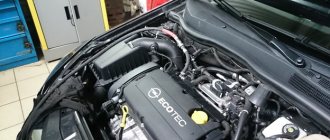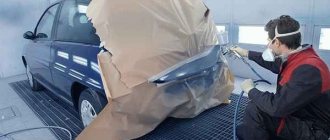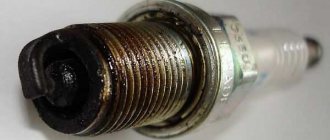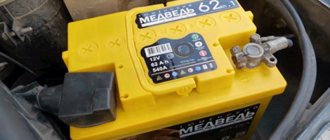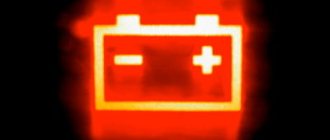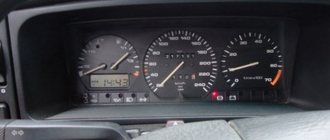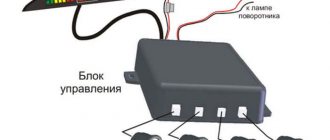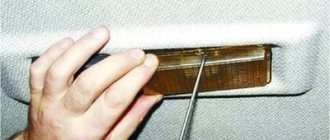Fogging of headlights is a common occurrence in cars and manifests itself in the form of droplets on the inner surface of the optics. This effect is called moisture condensation. The appearance of condensation is caused by the temperature difference inside the headlight and outside. In this case, the glass of the car headlight acts as a boundary layer on which moisture settles in the form of droplets.
The formation of condensation indicates a violation of the ventilation regime.
Optics most often fog up in conditions of high environmental humidity (rain, snowfall, fog). If there is condensation on the optics, the efficiency of headlights illuminating the road is sharply reduced. This is due to the fact that water droplets act in the form of small lenses, through which the light flux is refracted. Therefore, if condensation appears inside the headlight, the causes of its formation must be eliminated. This will make you feel more confident in difficult road conditions and increase safety when driving.
It is impossible to eliminate condensation by heating the optics with a light bulb, since ventilation is impaired and there is nowhere for moisture to evaporate from the headlight.
Foggy headlight
The fogging is so strong that it does not even allow you to determine the type of headlight.
The fogging is so strong that it does not even allow you to determine the type of headlight.
Generally speaking, absolutely all headlights and other car lights are a priori leaky. It cannot be otherwise: when heated, the temperature inside any headlight can easily change by 100 degrees! From minus 35, achievable in winter even in central Russia, to 60–70 degrees with the headlights on in the summer, in the sun. In addition, the rear part of the headlight is located in the engine compartment, where, as a rule, it is quite hot. At the same time, the air in the headlight naturally expands, and therefore cannot be avoided without exchange with the external environment.
Where there is contact, there is always the possibility of fogging. For example, if a cooling headlight sucks in moist air - say, at a car wash, then the transparent cap (previously it was a diffuser) according to the laws of physics has the right to become somewhat cloudy. Well, if the headlight has defects, then it has a much higher chance of fogging up. The once beloved Volga of one of the authors began to attract attention because the headlight glasses behaved differently - one was more transparent than the other. Soon everything became clear: during a visit to the service, one diffuser fell off by itself!
Is fogging dangerous? Without a doubt. It distorts the light distribution, which disturbs both the driver (the illumination of the road decreases) and other road users (it blinds them).
How to overcome fogging of headlights and flashlights
Many car owners have experienced fogging of headlights and taillights. If condensation that appears from the inside on the glass of lighting devices disappears soon after the headlight or lantern is turned on, it is treated as an annoying misunderstanding. However, moisture is not always so easily dealt with, and then it becomes a problem that has at least two serious consequences.
Firstly, when mixed with dust, which can also penetrate the headlight or flashlight, moisture initiates corrosion, which affects metal parts and electrical connections. This can lead to damage to the mirror coating of the reflectors to the point where it is necessary to replace the reflector, failure of electric corrector motors, xenon headlight ignition units, light bulbs and other components.
Secondly, the quality of light that the headlights are supposed to provide deteriorates. Each droplet is a miniature lens that refracts and scatters the light beam that the headlight should form. As a result, road illumination deteriorates, which in itself does not contribute to traffic safety, and also causes the driver to strain his eyesight and get tired faster during the trip.
There are known cases when fogging of the headlights became the reason for the car’s refusal to pass inspection. There is a solid basis for this in the traffic rules, recorded in the list of faults, which prohibits the participation of vehicles in road traffic if there are objects (liquids) not intended by the design inside the optical elements of their lighting devices.
We talk about the causes of fogging and ways to get rid of this problem with Yuri Borisenko, a specialist in the repair and adjustment of automotive lighting equipment :
— I can not only tell you, but also show you why headlights and lanterns fog up. For example, recently an owner who had imported an Infiniti from Russia approached me with this problem.
What immediately caught my attention was that the sweating headlight was set with gaps that should not have been there if the car had not been in an accident. Since there was an impact, it means that the headlight housing could have been damaged and lost its seal.
I lifted the hood and saw that the headlight was not even screwed to the body. But they didn’t screw it on because the hole in the headlight ear did not coincide with the base hole for attaching the ear to the body. If they started to tighten the eyelet with a bolt, something would break. As a result, whoever did the renovation left the place as is.
But elsewhere the repairmen did their best. Due to the impact, the wing mount cross member moved 2-3 centimeters to the side, so the factory mounts did not line up. Instead, two new holes were drilled for non-standard bolts and nuts. Since the signs of an accident were obvious, I began to look for a crack in the headlight housing.
I didn't have to search for long. From my experience I can say that in no less than 90 percent of cases it is damage that causes fogging of headlights and flashlights. Whether this problem can be overcome depends on the nature of the damage. A crack or small chip can be repaired with a soldering iron, glued or covered with silicone - depending on the owner, that’s up to you.
What is noteworthy in this case is that not only did a crack appear on the headlight due to the impact, but the mounting lugs also broke off. It is clear that they were restored, but why they did not repair the crack on the body is a question. This often happens: they repair a headlight, but they do it thoughtlessly. The ear was restored, but they ignored the fact that there was a crack - it was small and didn’t seem to affect anything. But it was through it that water got into the headlight in the rain and during washing.
Other causes of fogging relate to problems with the ventilation of headlights and lanterns, or to factory defects in sealing the joint between the glass and the housing, leaky fastening of light bulbs, electrical correctors, and casings covering the compartment where the lamps are located.
In this particular case, Infiniti had to remove the vapor barrier membrane from the headlight breather. Lighting devices are equipped with breathers so that the housing is ventilated from the inside and so that the air expanded from heating has the opportunity to escape from the headlight. When the headlight cools down and the air inside is compressed, the part of it that was forced out when heated returns to the headlight through the ventilation ducts. The purpose of the membrane is to prevent humid and dusty street air from entering the headlight. Air passes through, moisture and dust remain on the membrane.
Over time, the membrane becomes clogged. The headlight stops ventilating, and this is also the cause of fogging. If you try to blow out the membrane, but it tries to inflate like a balloon, then it needs to be changed. But try to find a repair kit.
Therefore, they usually follow a simple procedure - remove the membrane altogether. Such membranes are an example of Japanese engineering excellence. It turns out that there are plenty of eccentrics in Japan too. In addition to the fact that the membrane performs its function only for a few years and then becomes unusable, in the headlights of Japanese cars you can often see only one breather, although, in my deep conviction, there should be at least two of them - at the bottom of the headlight and at the top, for convection to occur. At the same time, on the casting of the headlight housing there may be places for two or three air vent valves, but for some reason they are muffled. Then you can drill a hole - the headlight will begin to “breathe” normally, which helps to cope with fogging.
Non-Japanese manufacturers usually do not suffer from this. Their headlights and lanterns have as many breathers as needed; the breathers themselves are a simple rubber U-shaped elbow, sometimes with a piece of foam rubber inside. So, when removing the membrane, there is no need to be afraid that dust will flow into the headlight. The experience of other manufacturers shows that a simple breather without any membranes copes with its task quite well - the headlight is ventilated and does not sweat, dirt does not penetrate into it, the breather itself is almost eternal.
As for the factory defect in the leaky fastening of the casing covering the compartment where the lamps are located, again, I recently had one Volkswagen.
There were signs of an accident under the hood, but when I removed the headlight and began to inspect it, I found no damage to the body. I assumed that the leak appeared at the junction of the glass and the body. I don’t know what kind of sealants some manufacturers use to glue glass to the body, but often after some time the sealant dries out, cracks appear in it, and when you start to detach the glass, the sealant falls out like dust.
True, in this case the sealant had nothing to do with it. I poured water into the headlight and it didn't leak anywhere. This means that there are no leaks between the glass and the body. I dried the headlight, assembled it and began to pour water on it from the outside until condensation appeared on the glass from the inside.
I dried the headlight again and carefully opened the lamp compartment. There were traces of leakage on its lid.
The problem was caused by a “chewed” rubber seal. In my opinion, this is a design flaw. It was possible to install the lid tightly only after several attempts - the rubber band kept trying to twist out and “escape” from its place. I have no doubt that when it is necessary to replace a burnt-out lamp in a headlight in order to hermetically close the lamp compartment, the headlight will have to be removed - you can’t do this correctly on a car, no matter how hard you try.
Also in the same Volkswagen there was water in one of the fog lights. Everything turned out to be simple with her.
I removed the fog light and found a hole in the upper part of the housing. I sealed it with silicone - water stopped flowing into the headlight. Generally speaking, it is not always so easy to deal with the problem. It happens that you find several obvious reasons and eliminate them, but the headlight continues to fog up. This means that there is something else that is not visible to the naked eye. Diagnostics is needed, and in the case of fogging, it only consists of pouring water into the headlight or watering the outside of the headlight and then looking for leaks. After fixing the problem, it is important to completely dry the headlight using a household hair dryer, or, if carefully, a technical one. Moreover, if it is easy to remove moisture from the internal space of the headlight housing, then for hidden cavities, which are electric motors and other components, a long “frying” with a hairdryer will be required.
Our verdict
The main reason for fogging of lighting equipment is mechanical damage to headlights and lanterns. In addition, lighting devices can fog up if there are problems with housing ventilation and sealing the joint between glass and housing, due to leaky fastening of light bulbs, electrical correctors, and casings covering the compartment where the lamps are located. It is possible to defeat fogging, but to do this, in each specific case, you need to find all the reasons why water penetrates inside the device.
Sergey BOYARSKIKH Photos by the author and Yuri BORISENKO ABW.BY
Cloudy headlight
The low beam of Largus's headlights is greatly distorted.
The low beam of Largus's headlights is greatly distorted.
At the same time, increased humidity inside the headlight housing destroys the coating of the reflectors. Well, there’s nothing to say about electrics: water and contacts will never make peace.
If the headlight is working properly, then, in general, there is nothing to be afraid of. The fogging will disappear as quickly as it appeared. The headlight, as we already mentioned, in cheap designs there is a tube directed downward, while more modern cars use special breathers with small filters for ventilation.
Reasons for fogging of optics
To understand the reason for condensation formation, you need to remember physics from your school course. In a closed space, as the temperature rises, the pressure also increases. In this case, the headlights act as a closed volume, and car light bulbs act as a heat source.
The type of optics does not affect this process in any way; even LEDs generate heat. If the headlights are made as sealed as possible, then at some point the housing will be damaged due to the increased pressure. First, the sealant that connects the glass to the plastic case will not hold up, then the seals at the point where the wiring enters will lose their properties. These places are the most problematic for headlights to fog up.
In the photo, the white caps are breathers from the Lada Largus headlight
To ensure that the headlight is sealed, but at the same time it is possible to equalize the pressure, its design includes breathers - specially designed holes. Thanks to them, dirt does not get inside the optics, cold air enters from below, and heated air comes out from above, removing moisture from it.
When you turn on the headlights, the lamps begin to heat the air inside the headlight, the pressure increases, according to the laws of convection, air begins to circulate through the breathers and excess moisture comes out with the outflow. If everything is working properly and works in the prescribed mode, then condensation will not form inside the optics. The air exchange that occurs is not a quick process, because The breather holes are small. Therefore, even working optics may fog up slightly during the first time after starting the car in rainy, humid or cold weather. LED bulbs use little energy to produce light and therefore produce less heat, so they are less susceptible to condensation.
After washing the car or in the off-season, air with high humidity is sucked into the headlight and when it cools, water droplets form inside. Fogging usually occurs in the area closest to the radiator grille and disappears after a short period of time.
The manufacturer's specialists are calm about short-term fogging of the glass, because... this is a natural process. Cases where there is constant and abundant condensation inside the headlamp, as well as the presence of water in its lower part, are considered critical. In this scenario, it is necessary to urgently eliminate the causes of moisture formation.
There are several reasons that lead to the destruction of the tightness of the headlight elements and, as a result, to internal sweating:
- Damage to the headlight housing, including the appearance of microcracks invisible to the naked eye;
- Violation of the integrity of the sealed joint between the fairing and the body;
- Wear of the protective cover through which power is supplied to the light elements;
- Clogging of the breathers responsible for the circulation of the air mass;
- Inconsistency of light bulbs with the recommended ones (such elements may not adhere well to the contact, thereby forming fistulas through which moist air enters);
- An incorrectly installed lamp may cause fogging;
- Damaged optics (in the event of an accident, they may have seal defects that are invisible to the eye, for example, peeling of the sealant at the joints);
- Damage to the lighting hydraulic corrector. On some cars, hydraulic correctors are installed inside the optics, which are responsible for the level of luminosity (by turning the knob). Very often, on domestic VAZs, liquid from the device leaks into the headlight, thereby promoting sweating. This reason is specific and rare, but possible.
headlight
Fog light Kia cee'd.
Two breathers are clearly visible. One for each section. Fog light Kia cee'd. Two breathers are clearly visible. One for each section.
What faults can cause fogging? Everything is simple here: most often the ventilation is simply clogged with dirt. Headlights with cracks also “walk on their own.” Some cases of fogging are associated with unprofessional disassembly/assembly of the headlight.
In such cases, there is only one piece of advice. Repair the headlight until all joints are sealed, so that only the standard “breathers” remain. If this does not work, the headlight must be replaced. No desiccant in the form of silica gel or pieces of diaper will help a faulty headlight.
And yet, how dangerous are drops of water caught in a headlight? We carried out a simple experiment: using a syringe we pumped 20 ml of water into the optics of the editorial Largus - this is quite a lot. We turned on the headlights, waited, then turned them off - well, yes, the hubcaps became cloudy. The light distribution became ugly. However, after a couple of days, after a relatively short run, the effect disappeared: the water safely evaporated into the atmosphere. Which, in fact, was what needed to be proven.
Of the useful tips regarding anti-fogging, we will mention, perhaps, only one: be careful when washing the engine compartment under pressure. A strong jet can rip off the “breathing caps” and cause trouble, after which you will have to seriously tinker with the headlight or replace it altogether.
Ways to eliminate the problem of “crying” headlights
There are two options for eliminating the problem - temporary and major repairs.
Drying with a hairdryer
If for some reason it is not possible to carry out a full repair, then temporary measures can be used to eliminate “crying”:
- Blow dry. To get rid of excess moisture, blow the headlight with warm air. To do this, remove the plug through which the auto lamps are changed, and the internal space is blown out with a regular hairdryer. This procedure will temporarily solve the problem.
- You can put a substance inside the optics that collects moisture, such as silica gel, which you can buy at a pet store (litter).
The issue of eliminating fogging of car headlights can only be completely resolved by carrying out full-scale repair work:
Cleaning breathers
The reason headlights sweat is because the vents are dirty. Therefore, first of all, after an external inspection, clean the channels from dirt.
Access to the vents varies by vehicle. On some cars, for cleaning it is enough to open the hood and carry out work without disassembling the car. The design of other vehicles may involve either simple removal of the light-forming element or partial disassembly of the front part (for example, removing the bumper to gain access to the optics).
The optimal way is to dismantle the headlight from the car and completely wash it, followed by drying (pay special attention after carrying out the work to ensure that there is no moisture on the contact group).
If condensation continues to form after cleaning the ventilation ducts, this means that there are problems with the tightness of the internal space. Carry out a careful inspection or lower the closed headlight into water. Bubbles will appear where the seal is broken. Accordingly, we mark this place and eliminate the fistula using several layers of sealant.
Violation of the integrity of the sealant in seams and joints
If in some places the sealant seam begins to partially allow moisture to pass through, replace this area with a new layer of sealant. To do this, clean and degrease the damaged area and apply sealant. You can install the optics only after it has completely dried.
Not every sealant can be used to correct the problem. Some sealants release substances into the air that later form moisture.
A common cause of sweating is a violation of the tightness of the docking chip. And in this case, you can solve the problem with sealant.
Chevrolet Cobalt
The breathers of the Chevrolet Cobalt are sealed with blue non-woven material to prevent dust from entering.
The breathers of the Chevrolet Cobalt are sealed with blue non-woven material to prevent dust from entering.
Tell us in the comments if you have ever encountered fogging of lighting devices and how you dealt with this phenomenon.
Foggy headlight: treat or replace?
Possible consequences
A car owner should know what to do if a headlight fogs up. This is not as minor a problem as some may think. The formation of condensation and subsequent release of water inside the optics can potentially cause serious problems. Let us highlight the main ones:
- Decrease in glow quality. Fogging causes a layer of water to form on the lenses. Water already has the ability to refract light, causing it to become diffuse. And in combination with the design of the optics, what is formed on the road is not a clear spot of the correct shape, but some kind of shapeless blurry blot.
- Oxidation. Everyone knows that water and wires are not good friends with each other. Moisture promotes the development of corrosion and oxidation processes on metal surfaces. Moreover, it’s mostly the wiring that suffers first. The contacts oxidize, causing electric current to stop flowing normally through the wires. The result is a complete system failure. The electrical system of the entire vehicle may be damaged.
- Deflector. It’s not just metal that should be wary of contact with water. Reflectors can also be damaged. When the deflector heats up and there is moisture inside, a steam cloud will be created. If the deflector frequently comes into contact with steam, the reflector will eventually become dim, which will negatively affect the quality of the glow.
- Destruction. Let's say right away that this happens rarely. But the lamp can be destroyed if water comes into direct contact with a hot bulb. This is realistic if the housing or diffuser is damaged.
- Light bulbs. Some solve the problem by simply replacing the burnt out light bulb. But if you do not eliminate the cause of fogging, you will have to buy new lamps very often. This will gradually lead to the development of more serious faults affecting reflectors, lenses, wiring and metal corrosion.
The car owner’s first priority is to find out exactly why the car’s headlight fogs up on the inside. Without knowing the cause, it will not be possible to eliminate the possible consequences. You should not ignore the fact that there is a layer of water under the glass or plastic of the case. You already know the consequences. And hardly anyone wants to risk the integrity of the car and large financial costs.
What to do with foggy car optics? And should we pay attention to this?
Foggy headlight: treat or replace?Why is it necessary to troubleshoot?
Water in the optics unit is extremely undesirable and even dangerous. Here are just a few consequences:
- rapid wear of reflectors;
- frequent failure of light bulbs and diodes;
- there is a high probability of moisture getting on the wires, which leads to their oxidation and may result in a short circuit.
A beam of light passing through glass clouded by condensation turns out to be dimmer and more diffuse. Water droplets become an additional lens that changes the direction of light. Visibility is greatly impaired, which is very dangerous when driving in the dark or in poor visibility. For this reason, the car may be refused registration with the traffic police.
Headlights or taillights that regularly accumulate water will not last long because they operate in very unfavorable conditions . If the reflective coating is damaged, the scratches will begin to oxidize and the reflective film will bubble, which can no longer be eliminated. The entire optics unit will need to be replaced, which is not cheap. Also, water getting on hot light bulbs shortens their service life. Lamps and diodes burn out more often and also require replacement. Connectors oxidized due to moisture damage the entire headlight. Often, water-damaged wires cause a short circuit, which has serious consequences and can even cause a fire. Therefore, fogging of the headlight from the inside, especially regular and severe, cannot be ignored, but should be eliminated as quickly as possible.
The headlight sweats, what can this lead to?
The troubles that can arise when a car headlight sweats will not be long in coming.
In this case, the reflectors, diffusers or block adjustment mechanisms will be damaged first. Secondly, the internal gaskets will collapse. Thirdly, the evaporation will disrupt the alignment of the light beam and reduce the illumination of the roadway. In addition, a lens effect is formed, leading to light refraction. Fourthly, the performance of electrical parts will deteriorate. Moreover, the contacts in the headlight unit will oxidize and the wires will be destroyed.
If the headlights sweat, it is recommended not to turn on the optics until they are completely dry. In this case, the power connectors must be urgently disconnected. This is necessary to protect against insulation breakdowns. Gas-discharge lights are especially dangerous in terms of short circuits.
Proper cleaning and assembly
- It is advisable to clean the disassembled headlight from dust and dirt. Glass and reflectors must not be washed with aggressive detergents or hot water. The best solution is a solution of laundry soap and a soft, lint-free rag. Don't rub!
- Then the washed components should be rinsed generously with distilled water and left to dry naturally.
- Assembly is carried out using clean cotton gloves. A special sealant for headlights is applied to the seam (at this stage you need to work carefully and avoid breaking the lines of the composition).
- The glass is connected to the body and dried at room temperature for 24 hours.
- Then you can check the tightness. To do this, the headlight is immersed with glass in water and held for several minutes. In this case, water should not get into the holes on the back wall.
How to get rid of problems if headlights sweat: video about cleaning ventilation ducts
You can eliminate fogging of the head optics yourself. The main thing is to take your time and choose the right materials. Prevention is even more important. You should periodically check that the breathers are clogged. Try not to drive at high speed through puddles with your headlights on, and let the headlights cool down before visiting a car wash. Then the headlights will fog up less often and you won’t have to remove them for drying.
